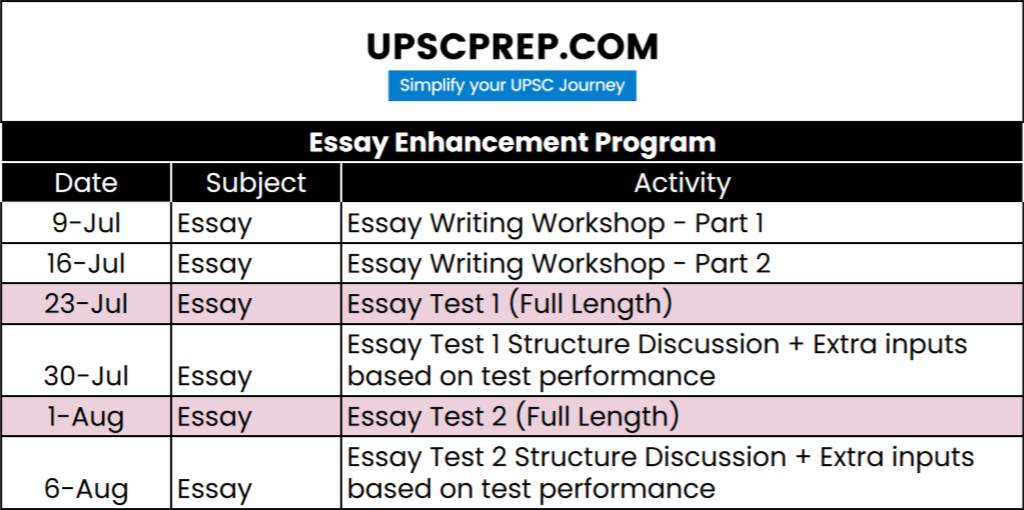Question-cum-Answer-Booklet
Model Solutions
Check out our Essay+Ethics Program -
(Last FEW Seats Remaining)

1. In context of the increasing importance of technology for disaster management, throw some light on the application of GIS and Remote Sensing in disaster management with specific examples from India. (150 words)
2. At the time of introduction, Goods and Services Tax (GST) was hailed as the biggest indirect tax reform since independence. Has the GST lived up to this expectation? Examine. (15 marks)
Model Structure 1.
Introduction
● With the recent advancements in technology, Geographic Information System (GIS) technology and Remote Sensing technologies have effectively improved the workflow in all phases of disaster management and provided effective remedial solutions.
Main body
Application of GIS and Remote Sensing in disaster management
● Mitigation stage:
○ GIS and remote sensing technology provides the capability to map and analyze hazards and visualize their potential impacts.
○ When hazards are fused with critical infrastructure, population densities, and other community values, vulnerabilities can be observed, modelled, and better understood.
○ Eg. Cartosat-1 was used for inundation vulnerability assessment of the Indian coastline in the event of a Tsunami.
● Preparedness:
○ Site selection for adequate evacuation shelters.
○ Selecting and modelling evacuation routes.
○ Identification and mapping of key tactical and strategic facilities like Hospitals, Public safety facilities etc.
○ Providing capability for the command and control information system that enables situational awareness and incident management support.
● Disaster Response:
○ Provide warnings and notifications to the public and others about pending, existing, or unfolding emergencies based on the location or areas to be impacted by the incident.
○ Maintain continuity of operations supply inventories, external power requirements, shelter population capacities, etc. at shelter locations.
○ Identify the locations and capabilities of existing public safety resources.
○ Provide the capability to create remote connections to the command center for officials and others who need to participate but are unable to come to the command center.
○ Establish the capability to share information and status with regional, state, and federal agencies.
○ Maintain incident status and progress reports; facilitate damage assessment collection and analysis.
● Recovery
○ Identification of damage.
○ Overall damage costs and priorities for reconstruction efforts based on appropriate local criteria.
○ Locations of business and supplies necessary to support reconstruction.
○ Determination of short term action for assessing overall critical infrastructure damage like First aid and health; Additional shelter needs; Optimum locations for public assistance; Alternate locations for government operations if government facilities are damaged etc.
Conclusion
● In addition, GIS data and remote sensing technology solutions are relatively cheaper and dependable. Hence, these technologies must be leveraged to generate an effective strategy to address all phases of disaster management in India and prevent economic and social losses.
Model Structure 2.
Introduction:
● GST is an umbrella, multistage, destination based indirect tax, which subsumes taxes like central excise, service tax, additional duties of excise & customs, VAT etc.(definition) or
● It was hailed as the biggest indirect tax reform of independent India due to its composition and envisaged impact.
Main Body:
Achievements of GST:
● Increase in Taxpayers- Number of taxpayers registered under GST rose to 1.3 crore by 2021.
● Increased Compliance-High tax rates of the pre-GST era acted as a disincentive to paying tax, the lower rates under GST helped to increase tax compliance.
○ More than 66 crore GST returns have been filed in the past four years.
● Ease of doing business- GST brought in a conducive environment for businesses by easing tax norms and giving tax concessions to corporates.
● One nation One tax- The multiple markets across India, with each state charging a different rate of tax, led to great inefficiencies and costs of compliance.
● Fiscal Federalism- The GST Council, that brings together the Central and State governments to improve the working of the mega tax reform.
Problems that persist in the current GST regime:
● Federal issues: Centre has failed to fulfil its promise on compensating the states in case of revenue shortfall. This was seen during COVID times.
● Inverted tax structure: ex- Paper, Leather etc.
● Taxing medical equipment: Items like vaccines, drugs, PPE kits, masks, ventilators, concentrators etc. remained under the taxed category.
● GST Collections- The expected growth in revenue has not happened and there seems to be stagnation in revenue growth.
● Problem of tax slabs- Despite best efforts the GST could not be imposed in 1-2 tax slabs.
○ The concept of sin tax and exclusion of several products like alcohol, petroleum products have created problems.
● Gaps in GSTN- CAG had highlighted poor backend management by GSTN in its audit report on GST.
Way Forward for reforms in GST:
● Revenue Guarantee- The income of states has seen a decline in the past 5 years, compounded by the expenditure due to Covid-19.
○ Assurance to states regarding Revenue Guarantee till 2026 is a welcome step.
● Reforms in GST Council- Reforms such as more weightage to the states, clarity on suggestions of council for borrowing etc.is required.
● FRBM ACT 2003- suitable relaxations in FRBM Act 2003 be made to account for larger fiscal deficit years in case of contingencies like Covid-19.
Conclusion:
● Therefore, the GST has been a mixed bag, it requires modifications before it produces the kind of benefits that were talked about prior to its roll out.
Previous Post